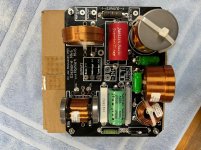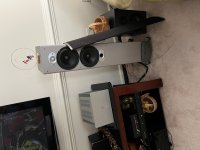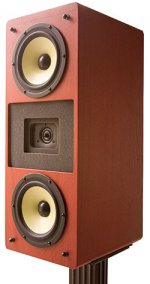Really depends on whether you are just going for a prototype or refined product. I normally just send a DXF file to the the stuff all curt via laser cutting. For more refined stuff, I am waiting on my Goliath router/cutter to come in.Thank you for the response. Yes you are right, design is simple enough to not require any fancy machine and efforts on finding better material may be the way to go.
To clarify : I meant CNC router table to cut all the panels, assembly ready, in one go from a 4'x8' sheet and a file. A sheet can be MDF/PLY/Composite/any better material one may choose.
Thanks
Elsinore Crossover Tweeter Polarity
Folks,
I recently completed my 2 Elsinore crossovers using the "black" circuit boards. I have not started on the cabinets yet, but I decided to hook up one of the crossovers to the 4 SB Acoustics drivers and Scan Speak tweeter to make sure that I had not screwed up the crossover build.
I noticed that the tweeter polarity is opposite the bass and mid polarities...so the tweeter is 180 degrees out of phase with the rest of the speakers?
I verified the polarity shown on the schematic with the actual board -- to make sure that the tweeter was marked as opposite polarity. Can someone explain this please...???
By the way, just for fun I opened up my Polk RT-8 2-way speakers, pulled out the 2 "6 inch" drivers in each cabinet, and replaced them with 2 of the SB's...could not swap out the tweeter --
Even though the Polk drivers seemed to be of pretty good quality (acoustic suspension and quite a large magnet -- heavy!!) the clarity and depth improved tremendously with the SB's in those cabinets. (I did notice that the SB Acoustics drivers had a lot more "throw" to the cone when I verified the speaker wiring polarity with a 1 1/2 volt D cell battery??)
My next iteration will be to cobble together the SB's in the Polk cabinets with the Elsinore crossovers and see how that sounds!!.
I'm Still waiting for winter weather to start the Elsinore cabinets but in the mean time, I think I'll enjoy my "hybrid" Polk speakers coupled with my Sony Vfet amp and Amp Camp Preamp -- and Elsinore crossovers.
So about that tweeter polarity?
Thanks,
Happy Jack
(Yes I know -- I butchered C5 when I reached the soldering iron across it to solder in L5 -- I changed my soldering order so that I did not mess up the 2nd crossover -- a Replacement for the burned C5 is on the way from HiFi Collective --)
Folks,
I recently completed my 2 Elsinore crossovers using the "black" circuit boards. I have not started on the cabinets yet, but I decided to hook up one of the crossovers to the 4 SB Acoustics drivers and Scan Speak tweeter to make sure that I had not screwed up the crossover build.
I noticed that the tweeter polarity is opposite the bass and mid polarities...so the tweeter is 180 degrees out of phase with the rest of the speakers?
I verified the polarity shown on the schematic with the actual board -- to make sure that the tweeter was marked as opposite polarity. Can someone explain this please...???
By the way, just for fun I opened up my Polk RT-8 2-way speakers, pulled out the 2 "6 inch" drivers in each cabinet, and replaced them with 2 of the SB's...could not swap out the tweeter --
Even though the Polk drivers seemed to be of pretty good quality (acoustic suspension and quite a large magnet -- heavy!!) the clarity and depth improved tremendously with the SB's in those cabinets. (I did notice that the SB Acoustics drivers had a lot more "throw" to the cone when I verified the speaker wiring polarity with a 1 1/2 volt D cell battery??)
My next iteration will be to cobble together the SB's in the Polk cabinets with the Elsinore crossovers and see how that sounds!!.
I'm Still waiting for winter weather to start the Elsinore cabinets but in the mean time, I think I'll enjoy my "hybrid" Polk speakers coupled with my Sony Vfet amp and Amp Camp Preamp -- and Elsinore crossovers.
So about that tweeter polarity?
Thanks,
Happy Jack
(Yes I know -- I butchered C5 when I reached the soldering iron across it to solder in L5 -- I changed my soldering order so that I did not mess up the 2nd crossover -- a Replacement for the burned C5 is on the way from HiFi Collective --)
Attachments
Tweeter polarity
Thanks ScottG --
I arrived at the Elsinore party quite a bit later than most of you folks -- so I was not aware of the Renegade Tweeter Theory -- Now that I'v read it a few times, it kind of makes sense --
But how much of the phase shift effect is due to the fact that the drivers and tweeter and crossover and case are all tuned to together?
In my case where I hijacked the drivers and crossover and put them into my Polk cabinet (and used the existing meager Polk-installed factory tweeter) does the phase reversal wiring still hold?
By the way, I know that this setup is sub-optimal -- but patience is not one of my fine attributes -- I'd have a hard time waiting for the cabinets to be built -- sub-optimal is still way better than factory Polk...
Happy Jack
Thanks ScottG --
I arrived at the Elsinore party quite a bit later than most of you folks -- so I was not aware of the Renegade Tweeter Theory -- Now that I'v read it a few times, it kind of makes sense --
But how much of the phase shift effect is due to the fact that the drivers and tweeter and crossover and case are all tuned to together?
In my case where I hijacked the drivers and crossover and put them into my Polk cabinet (and used the existing meager Polk-installed factory tweeter) does the phase reversal wiring still hold?
By the way, I know that this setup is sub-optimal -- but patience is not one of my fine attributes -- I'd have a hard time waiting for the cabinets to be built -- sub-optimal is still way better than factory Polk...
Happy Jack
I don't fully agree with that theory. If you look at the square wave response of a full range driver that is running in phase, it will have the leading edge go positive first and drop off gradually. The time it takes for the wave to drop off is equivalent to low end extension. An overshoot is indicative of ringing like a metal dome tweeter has. The more perfectly right angle the leading wave edge is, the more linear and ideally dampened the HF response is.
I don't fully agree with that theory.
That's fine, but then again I don't understand your critique of it?
The Lipinski L707 speaker also uses this method:
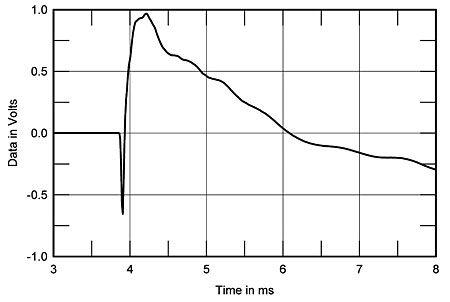
Above is the combined step response.
Below are the traces of individual drivers:
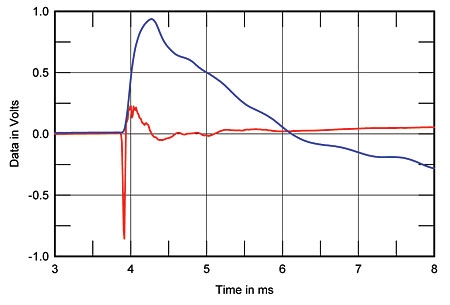
These examples are from Stereophile and John Atkinson's comments shows he understands exactly what is going on:
"In the time domain, the L-707's step response (fig.7) surprised me by indicating that the tweeter is connected in inverted acoustic polarity to the woofers. Despite the setback of the tweeter subbaffle and the low-order crossover filters, the speaker is not time-coincident. This was confirmed by looking at the step responses of the individual drive-units (fig.8). But what is important to note from this graph is that the overhang of the tweeter's inverted step (red trace) blends smoothly into the woofer's step (blue). This time coincidence correlates nicely with the excellent frequency-domain integration..."
What you get is 1st order electrically that sums at -6dB rather than Butterworth 1st order that sums at -3dB (that's bad).
Maybe you should also read this article, maybe that will help:
The "Joe Rasmussen Approach to Crossover"
BTW, my example in the article Renegade Tweeter is, as far as I remember, not that of the Elsinores. I have made it work with a variety of drivers and various designs that I have over the years.
That's fine, but then again I don't understand your critique of it?
The Lipinski L707 speaker also uses this method:
Above is the combined step response.
Below are the traces of individual drivers:
These examples are from Stereophile and John Atkinson's comments shows he understands exactly what is going on:
"In the time domain, the L-707's step response (fig.7) surprised me by indicating that the tweeter is connected in inverted acoustic polarity to the woofers. Despite the setback of the tweeter subbaffle and the low-order crossover filters, the speaker is not time-coincident. This was confirmed by looking at the step responses of the individual drive-units (fig.8). But what is important to note from this graph is that the overhang of the tweeter's inverted step (red trace) blends smoothly into the woofer's step (blue). This time coincidence correlates nicely with the excellent frequency-domain integration..."
What you get is 1st order electrically that sums at -6dB rather than Butterworth 1st order that sums at -3dB (that's bad).
Maybe you should also read this article, maybe that will help:
The "Joe Rasmussen Approach to Crossover"
BTW, my example in the article Renegade Tweeter is, as far as I remember, not that of the Elsinores. I have made it work with a variety of drivers and various designs that I have over the years.
I thought my explanation was sufficient, but here goes...
That example you gave of the L707 is a two way speaker with a passive crossover network. Unless it uses a true first order (HP + LP) network, it will give that transient response due to the tweeter showing the first spike, being out of phase with the woofer, then swinging 180 degrees back to a second spike and then dropping past zero and decaying (depending on LF dampening). A three way speaker would have an additional third peak, etc.
A true full range driver without electrical dividing network will (ideally) give you one fast rising peak, and then a gadual drop downwards, crossing the zero point and showing its low frequency dampening response. Only a true fullrange driver will give you the single peak and drop, then decay. It is the only type of speaker allowing for theoretically perfect transient response, hence coming the closest being able to reproduce a square waveform. The only excpetion to this is a 2 way speaker with a true first order HP and LP network.
I thought my explanation was sufficient, but here goes...
Are you critiquing a claim I have never made?
It is the only type of speaker allowing for theoretically perfect transient response, hence coming the closest being able to reproduce a square waveform. The only excpetion to this is a 2 way speaker with a true first order HP and LP network.
What do you call this?

Note the rounding at the leading edge and the small narrow peak on the trailing side. That peak is where the tweeter shows up, but above 10KHz.
Why would I do like that? That is the question that should be asked.
Because the design you describe, you did not note that I said that it sums at -6dB at the crossover and not, as your example would, at -3dB (and that is bad). Your argument is that only 1st order Butterworth (-3dB) is the only way to go. I beg to differ. 1st Order does not always mean Butterworth.
Read the two articles and it is all explained in excruciating detail and peer-reviewed so that the arguments stand up.
Before I wrote those two articles, I got hate email suggesting... actually I don't know what they were suggesting, it was just too crazy.
I thought writing those two articles and making them as bomb-proof as possible, would end it. Largely it did. But what was I guilty of? Making false claims? After reading those articles, nobody should have been able to do that.
As for designing 'transient perfect' loudspeakers and only if all the drivers are connected in the same positive polarity, then I assume you know about John Dunlavy and also his earlier company Duntech. It is still alive right here in Sydney. Do I have a connection with Duntech just down the road (the M5 to be exact)? I do (hi Kiat).
Let me put it this way, there are only two people on this planet that have computer-modeled the Duntech Sovereigns. One is John Dunlavy. Guess who is the other? Yep, you got it.
An externally hosted image should be here but it was not working when we last tested it.
That design follows the textbook design for a 'transient perfect' design, just as you say. In fact, John had in mind that the drivers combine as a focussed array 3.5M away, you have to be listening exactly at the tweeter height and dead on axis. It is very smooth response, but by the time you are 30 degrees off axis, all kinds of problems show up, and they are described in my two articles, but with posting anything about the Sovereigns as that would be professionally wrong. Dunlavy ignored the off axis response and he was actually influenced by Yagi antenna design (of which he held military patents) where in RF the off-axis diluted the on-axis performance. But it seems he was also ignoring room acoustics and critical hearing mechanisms. But still they worked, but they were actually giant headphones - only one listener and have his head in a vice. But this also applies to your 'transient perfect' design, which is actually what I want to avoid, yes the very thing you suggest I should do.
Andrew Lipinski had a relationship with the late John Dunlavy and clearly came to similar conclusions that the textbook 'transient perfect' approach should be amended because of similar concerns to mine. His design reads like an open book on this.
My reasons for connecting the tweeter out of phase, and think about this, if it had an infinite rise time, then it would also satisfy your need, except the step response would start elsewhere and that would be corrected by tweaking the offset between the drivers so that the pulses line up in time.
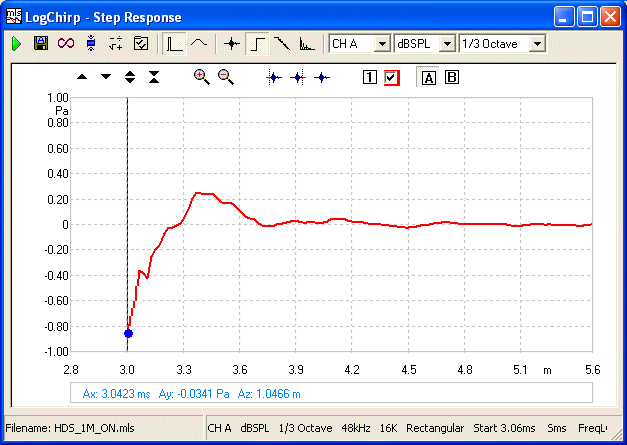
See where the step response of the tweeter starts if it has an infinite rise time? Can you see it? But of course it is not infinite, so what you need to do is get rid of that part of the response, typically well above 10KHz when power input is 1 Watt or lower. Yes, this is a pole that swings in frequency with power input (analyse it and you will realise why), but it is in the top octave only. That is why you see only that small trailing peak in the measure square wave above. The advantages outweigh the minor disadvantages in so many different ways.
If this is not clear, then I defer to those who have built Elsinores and ask them what they think. That's all.
PS: The Elsinore design is actually far more concerned about how the current of the amplifier affects the sound, so there is an entirely different layer going on here.
Last edited:
But how much of the phase shift effect is due to the fact that the drivers and tweeter and crossover and case are all tuned to together?
It's relative to the acoustic center/setback of the midrange.
Basically, to get good integration the tweeter must be physically deeper into the cabinet relative to the midrange. (..of course the net result of the high-pass/low-pass for each driver (mid. and tweet) is also critical.)
Joe does this with a waveuide, but you could also do a stepped-baffle (tweeter inset) with some foam around the tweeter to decrease diffraction.
Attachments
Last edited:
I don't fully agree with that theory. If you look at the square wave response of a full range driver that is running in phase, it will have the leading edge go positive first and drop off gradually. The time it takes for the wave to drop off is equivalent to low end extension. An overshoot is indicative of ringing like a metal dome tweeter has. The more perfectly right angle the leading wave edge is, the more linear and ideally dampened the HF response is.
I only posted it because the question on polarity.
As to the theory? Eh, don't care about it - but I do care about the net result: look at the driver's phase. (..of course the Impedance is also excellent.)
The overall design is excellent (..except of course for vertical dispersion: as with most loudspeakers.)
Can you link to the driver phase plots?look at the driver's phase.
I only posted it because the question on polarity.
As to the theory? Eh, don't care about it - but I do care about the net result: look at the driver's phase. (..of course the Impedance is also excellent.)
The overall design is excellent (..except of course for vertical dispersion: as with most loudspeakers.)
I'm starting to feel guilty for asking the question about polarity of the tweeter that started this string. So since I'm already feeling a bit guilty, one more question --
Since it is very easy to switch the polarity of the tweeter, has any of the Elsinore builders taken the approach of listening to the speakers first as designed and then with the tweeter polarity switched and then commented on the sonic difference?
HappyJack
Since it is very easy to switch the polarity of the tweeter, has any of the Elsinore builders taken the approach of listening to the speakers first as designed and then with the tweeter polarity switched and then commented on the sonic difference?
By all means try it. But it would be a waste of time, I'm afraid. All it would prove is how bad it would sound because you would have a deep suck-out near two octaves wide. It would sound very sick indeed and you would quickly correct it and get it sound right again.
OTOH, what would happen if you did this to a 'transient perfect' Butterworth crossover? In theory, the response should stay flat, no matter what the phase.
Indulge me, and I will try to explain below without sounding too preachy.
Imagine 3KHz crossover:
1. The ideal Butterworth, reversing the phase would not change the frequency response in theory. But the step (or square wave) would look wrong.
2. The ideal crossover as used in the Elsinore, would theoretically cancel out near 100% at 3KHz.
So one would stay flat, the other would have a huge suck-out.
In reality, because the drivers response either side of 3KHz needs to have flat frequency response at least one octave or more either side of the crossover frequency, so even Butterworth won't be flat when reversing the tweeter, even though the theory says it should. But it will still be flattish. It will not have a massive suck-out.
Here is the explanation why this is the case, let us concentrate on what Butterworth does and does not do: To my way of thinking, at the centre of the crossover frequency, both drivers should be going forward, and then backwards, at the same time. They must be in sync. In phase.
But this does not happen with Butterworth 'transient perfect' crossovers. The two drivers are only in sync 50% of the time.
Here is what it, Butterworth, does:
The starting position of the cycle:
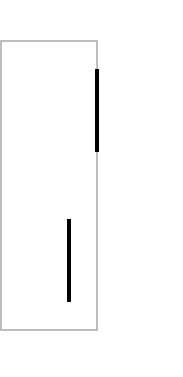
The first quarter of the cycle creates a forward going pressure:
All of this would be mute if we could find a single driver that can cover all frequencies and no need for a crossover. But alas, we don't have that, so we have a "potpourri of compromises" to choose from, and I am definitely biased towards the compromises that I and Andrew Lipinski have taken. He goes even further by only wanting sealed boxes. I, OTOH will go with vented boxes, provided you know how to get them right and I have put some effort into that.
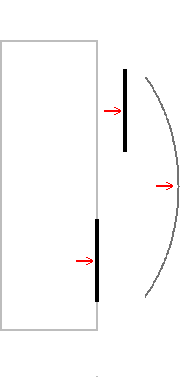
The second quarter of the cycle, the output of the two drivers are cancelled out, in fact, there is no output:
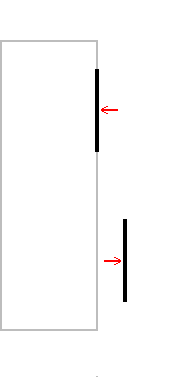
The third quarter of the cycle will have inward pressure and hence output. The fourth quarter of the cycle will have no output.
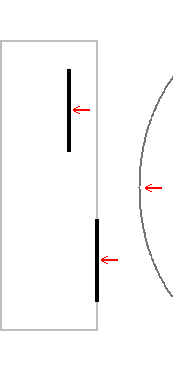
So you have lost half the output at the centre of your crossover frequency.
This is why Butterworth have the cross over at -3dB, because you need double the output to get a flat response compared to -6dB which means that all four cycles are working together. (It also means more distortion from the tweeter, but that is another topic).
The importance off axis is critical but ignored in Butterworth.
The problem? Here the tweeter is usually OK, but the midrange driver's response will be falling of quicker off axis than on axis. The tweeter can fill that in and is very useful doing that. Butterworth only half fills that in because every second quarter of the cycle is lost.
The 'transient perfect' goal only works when dead on axis and it is just not good enough. So a compromise is required and it becomes about finding the best one. I reckon I found what I consider IS the best compromise by far. And that somebody like Lipinski came to the same compromise, that pleases me greatly, because I believe we both ended up looking at the same problems as I did.
But that is my view, that is all.
Now I think I have covered things enough. The two articles, it's all in there.
I'm starting to feel guilty for asking the question about polarity of the tweeter that started this string. So since I'm already feeling a bit guilty...
Don't feel guilty. You asked the question as a query and not as an attack. Big difference.
Wasn't Joseph D'Appolito's MTM based on Butterworth?The importance off axis is critical but ignored in Butterworth.
Don't feel guilty. You asked the question as a query and not as an attack. Big difference.
Joe, I'm not trying to instigate something here. I'm disagreeing with the "renegade tweete" concept. Thats all and there's no need to get flustered about it.
The waveform you posted can't come from that speaker if the transient response looks like the measurements taken in the review... not with that out of phase tweeter peak.
Ive built, owned and listened to many speaker designs that claim near tarnsient perfect response characteristics. The Dunlavys are some of them, as well as the Manger Zero 109s which I personally own along with the A26 clones that run first order networks. I used to obsess about speaker transient behavior and researched it to death. I'm now a big multi-way LR2 proponent... go figure.
Sorry to have opened up a can of worms here.
I only posted it because the question on polarity.
As to the theory? Eh, don't care about it - but I do care about the net result: look at the driver's phase. (..of course the Impedance is also excellent.)
The overall design is excellent (..except of course for vertical dispersion: as with most loudspeakers.)
I wasn't really intending to quote you personally. Your post had the link in it. Sorry
Wasn't Joseph D'Appolito's MTM based on Butterworth?
Yep. Got his book just a few feet above my head. It is an important book. Near next to it is Esa Merileinen's "Current-Driving Loudspeakers" which I also consider important and told him so. But both have certain conclusions that I am not entirely on board with.
To you Allen, I don't consider you a fool and you have been following things here for some time - and you are just down the road from me (I live just of the Hume H'way before coming into Sydney, so technically correct, even if it is 900Km
So let me give you some longer term context and hope you get it (I am an optimist):
My own view is that the benefit of ALL 1st order filters is that the main series elements, being a single inductor on the bass/mid, and the single series capacitor on the tweeter, is that has a significant benefit to the current. It cleans it up (now I am on dangerous ground, given past experience).
Here is my point and I try to choose my words carefully: The reason they like that 1st order sound, I believe is down to something else. I understand what it is they like in the sound. By now it should be obvious that I am very familiar with Duntech speakers and they, for the most part, have that sound.
I think the real reason they like the 1st order sound is the way that the current of the amplifier interacts and to use John Atkinson's phrase "they sound more accessible."
But it needs to be 1st order, but it does not have to be 1st order Butterworth. Get away from what they think is the reason for the sound (phase/step etc) and concentrate on what the current is doing as far more important, then you get the kind of sound that Esa talks about in his book, the sound of current drive, but you are not using current drive and yet you still get that sound.
It's complicated, I know. It is only the tip of the iceberg.
But when I have tried to have that discussion online, it did not turn out well. It caused a storm. Particularly the phrase "back-EMF impedance" riled the knights of orthodoxy. It is not a textbook phrase and "wrong terminology."
Discussions offline and with people who I respect and their respect reciprocated have been amazingly productive. Yes, something will come out on paper on this and it will include actual measurements, actual distortion measurements, and some really interesting surprises. But it will also be a challenging read for some. As one physicist said, "thinking voltage is easy, thinking current is hard." I would love to name him, but not for now, but I suspect it is a name you would recognise, and he is but one.
What Esa tries to explain as the sound of current-driving is what I believe what so many people like about the sound of the Elsinores: They sound so engaging, sounds of musical instruments get separated out in space in a very easy-on-the-ear way, and it comes out of the box rather than trapped by it.
I have a 40 Watt current-source amplifier right here. I know the sound. Feed to a compatible speaker, maybe even fullrange (a good one) and there is THAT sound. The sound of current-drive. The sound that Esa says he can recognise as current drive coming into the room.
And it comes down to suppressing that notorious "back-EMF impedance" of the driver(s).
So there, I said it. Now will I be in trouble again?
The larger you can make the series inductor, the better and the greater the suppression of the non-linearity of the driver on the current side. Make the internal non-linear drive inductance as small as possible (good driver selection important) and make the external and much more linear inductor as large as possible. It then suppresses the internal non-linear inductance and now you get something closer to the sound of current drive. Now EQ the total current of the amplifier and you make it supply the same current at all frequencies, and you have put the cherry on top. Make the current phase angle of the amplifier flat zero degrees across the board - now come more of THAT sound - and it is better than any Duntech (I don't want to sound like I am boasting, but I know what I know).
Here being -6dB means you use a larger inductor value than -3dB.
That's big! For the tweeter, the value is smaller, it is similarly, but the technique required is different and will not bring that up too much here, but again sum at -6dB and you will get lower distortion, but you have to suppress the sub-1KHz resonance - that LC null you see in the Elsinore crossover.
The Elsinores are not the only design - I have done 2-Ways, 3-Ways and we (a team) are about to put together and all active 3-Way that does use all current drive amplifiers, including on the bass. How it is done on the bass will contain a true surprise. I am going to get into trouble, but you can make a sealed box with a Q=0.71 and when coupled to a current source will become a Bessel Q=0.56 by controlling the current versus frequency at the 50 Hertz sealed box resonance. Yes, the damping will increase under current-drive versus voltage drive. This is the exact opposite to what is expected, but it works. You see, I have already done it. It's a tailored LCR working against the fixed current of the amplifier. So there you are.
Last edited:
- Home
- Loudspeakers
- Multi-Way
- The "Elsinore Project" Thread
